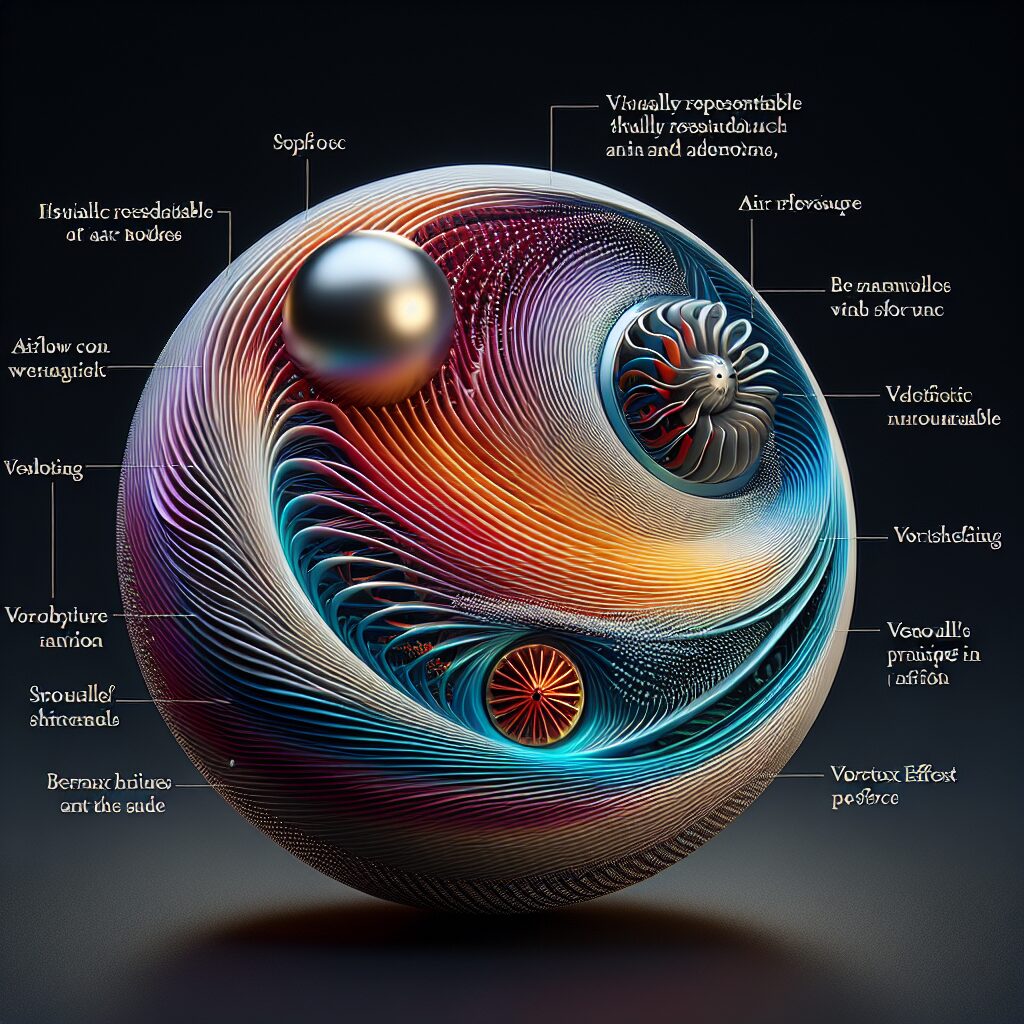Fluid dynamics plays a crucial role in understanding the intricate aerodynamics of a ball in motion. With its complex interplay of forces and fluid behavior, this field of study offers valuable insights into the behavior of objects in fluid mediums. A defining aspect of fluid dynamics is the study of how gases and liquids flow, interact, and exert forces on objects within them. In the context of ball aerodynamics, fluid dynamics examines how the air surrounding the ball influences its trajectory, spin, and overall flight characteristics.
One key impact of fluid dynamics on ball aerodynamics is the phenomenon of drag. Drag is the resistance force experienced by a ball as it moves through the air. It arises from the interactions between the ball’s surface and the air molecules in its surroundings. Understanding the intricacies of drag is essential in predicting and controlling the flight path of a ball. Moreover, the study of fluid dynamics allows researchers to investigate the effects of varying factors such as velocity, surface roughness, and atmospheric conditions on drag. By delving into the realm of fluid dynamics, scientists and engineers gain valuable insights into how to optimize the design and performance of balls, thereby enhancing their aerodynamic properties.
Moving forward, this article will delve deeper into the fascinating world of fluid dynamics in ball aerodynamics. We will explore key takeaways that shed light on the influence of surface texture, spin, and ball shape on its flight characteristics. By examining these pertinent aspects, we aim to unlock valuable knowledge and equip readers with a deeper understanding of the complex interplay between fluid dynamics and ball aerodynamics. So, let us embark on this insightful journey to unravel the hidden intricacies that govern the behavior of balls in motion.
Key Takeaways
1. Ball aerodynamics depends on complex fluid dynamics, which involve the interaction between the ball and the surrounding air, resulting in various forces acting on the ball’s trajectory.
2. Different factors, such as air density, ball speed, spin rate, and surface roughness, significantly impact the ball’s behavior in flight, affecting its trajectory, distance, and accuracy.
3. Lift force and drag force are two major forces in ball aerodynamics. Lift force causes the ball to deviate from its initial trajectory, creating the phenomenon of ball movement in sports like golf, tennis, and soccer. Drag force opposes the ball’s motion and determines the resistance it experiences while in flight.
4. Magnus effect explains the curvature of the ball’s trajectory due to the spin it obtains. Depending on the direction and speed of the ball’s spin, the Magnus effect can cause the ball to bend in the air, affecting its overall path.
5. Understanding the intricacies of ball aerodynamics is crucial for athletes, engineers, and sports equipment manufacturers to optimize performance, develop advanced techniques, and design better equipment for a wide range of sports. This knowledge allows for informed decisions on factors like ball design, weight distribution, and surface properties to enhance performance and achieve desired outcomes.
What are the intricate details of fluid dynamics in ball aerodynamics?
The Importance of Fluid Dynamics in Ball Aerodynamics
Fluid dynamics plays a crucial role in understanding the behavior of objects, especially in the field of ball aerodynamics. When it comes to balls used in sports such as football, baseball, or golf, comprehending the intricate details of how fluids interact with these objects becomes essential. In this section, we will delve deep into the significance of fluid dynamics in ball aerodynamics.
Key Factors Affecting Ball Aerodynamics
Various factors come into play when considering the aerodynamics of a ball. Understanding these factors helps us analyze the intricate details of fluid dynamics in this context. Some of the key factors include:
- Ball shape and size
- Ball surface texture
- Air pressure and density
- Ball spin and rotation
Effect of Ball Shape and Size
The shape and size of a ball significantly impact its aerodynamic properties. The intricate details lie in understanding how different shapes and sizes affect drag, lift, and stability. The fluid dynamics behind these phenomena determine how the ball moves through the air and interacts with external forces.
Influence of Ball Surface Texture
The surface texture of a ball is another crucial factor in fluid dynamics. The intricate details of how the texture affects air flow over the ball’s surface can impact its trajectory, speed, and stability. Studying the micro-level interactions between the fluid and ball surface provides valuable insights into optimizing ball aerodynamics.
Air Pressure and Density Considerations
Air pressure and density play a significant role in ball aerodynamics. The intricate relationship between these factors and fluid dynamics affects the ball’s behavior. Understanding how changes in atmospheric conditions impact the ball’s flight enables athletes and engineers to make informed decisions during various sports activities.
Ball Spin and Rotation: Unraveling the Complexities
Ball spin and rotation bring forth a new layer of intricacies in fluid dynamics. Whether it’s a football spiraling through the air or a golf ball curving mid-flight, comprehending the effects of spin and rotation on the ball’s trajectory requires a deep understanding of fluid dynamics. This knowledge allows for improved precision and control during sports.
Maximizing Efficiency through Fluid Dynamics
The intricacies of fluid dynamics in ball aerodynamics provide opportunities to enhance performance and efficiency. By harnessing the knowledge gained through studying these intricacies, engineers and athletes can optimize ball designs, minimize drag, maximize lift, and improve overall performance in various sports activities.
Tips for Optimizing Ball Aerodynamics:
- Experiment with different ball shapes and sizes to find the best aerodynamic properties.
- Ensure the ball’s surface texture is designed to minimize drag and maximize airflow.
- Consider the environmental conditions, including air pressure and density, for accurate ball behavior predictions.
- Experiment with ball spin and rotation techniques to gain better control and precision.
- Continually analyze and research the latest advancements in fluid dynamics to stay ahead in optimizing ball aerodynamics.
Frequently Asked Questions
1. How does fluid dynamics affect ball aerodynamics?
Fluid dynamics plays a crucial role in ball aerodynamics as it determines the behavior of air or any other fluid around the ball. Factors such as air pressure, ball speed, spin, and surface texture all interact with the fluid dynamics to influence the trajectory, lift, and drag experienced by the ball.
2. Why is understanding ball aerodynamics important?
Understanding ball aerodynamics is vital in various fields such as sports, engineering, and aviation. It helps in optimizing ball designs, enhancing performance, predicting flight paths, and developing innovative technologies. Moreover, it enables players, engineers, and scientists to make more informed decisions and achieve desired outcomes.
3. What is the Bernoulli’s principle and its role in ball aerodynamics?
Bernoulli’s principle states that as the speed of a fluid increases, its pressure decreases. This principle is significant in ball aerodynamics as it explains how differences in air pressure around the ball create lift or downward force. By understanding Bernoulli’s principle, we can comprehend how different factors affect ball flight and design efficient balls for specific applications.
4. How does the surface texture of a ball impact its aerodynamics?
The surface texture of a ball greatly influences its aerodynamics. Texture affects the boundary layer of air surrounding the ball, which in turn affects the drag forces. A smoother ball surface reduces drag, allowing for greater speed and longer distances. Conversely, a rough surface creates more turbulence and higher drag, influencing the flight characteristics and overall performance of the ball.
5. What role does spin play in ball aerodynamics?
Spin is a crucial factor in ball aerodynamics as it affects the lift and trajectory of the ball. Backspin on a ball creates an upward force, causing it to stay aloft for longer distances. In contrast, topspin exerts a downward force, making the ball dip faster. Understanding the effects of spin helps athletes in sports like tennis, baseball, and golf control ball flight and achieve desired outcomes.
6. How do different ball designs impact their aerodynamic properties?
Ball designs have a significant impact on their aerodynamic properties. Factors such as shape, size, weight distribution, and dimple patterns can alter the drag, lift, and stability of a ball. Specific designs are fine-tuned for different sports and applications to optimize performance. For example, golf balls feature dimples to enhance lift and reduce drag, while footballs have a unique shape to improve flight stability.
7. How does ball speed affect its aerodynamics?
Ball speed directly influences its aerodynamics. Higher speeds result in greater magnitudes of lift and drag forces acting on the ball. Understanding how speed affects aerodynamics helps athletes and engineers optimize performance, predict ball behavior, and fine-tune equipment for various sporting events or applications.
8. Can temperature and humidity affect ball aerodynamics?
Yes, temperature and humidity do impact ball aerodynamics. Changes in air temperature and humidity alter the air density, which in turn affects the ball’s flight characteristics. For instance, lower air density at higher altitudes can lead to increased lift and distance in some sports like golf. It is essential to consider these factors when analyzing and predicting ball behavior.
9. How do environmental conditions like wind affect ball aerodynamics?
Environmental conditions like wind have a significant impact on ball aerodynamics. The presence and direction of wind can alter the path, speed, and trajectory of a ball, making it challenging for athletes to predict and control ball flight. Understanding these effects helps in adjusting game strategies, selecting appropriate equipment, and developing techniques to mitigate or utilize wind-induced changes.
10. How is fluid dynamics relevant beyond sports?
Fluid dynamics extends far beyond sports and finds applications in various industries. It plays a vital role in aerospace engineering, naval architecture, automotive design, and even weather prediction. Understanding fluid dynamics enables scientists and engineers to study and optimize the behavior of gases and liquids, enhancing efficiency, safety, and performance in multiple domains.
Final Thoughts on The Intricacies of Fluid Dynamics in Ball Aerodynamics
The intricacies of fluid dynamics in ball aerodynamics are fascinating and have far-reaching implications. This field of study not only enhances our understanding of sports but also contributes to advancements in technology, design, and innovation. By comprehending the intricate interplay between fluid dynamics and ball aerodynamics, we can unlock new possibilities, revolutionize sports performance, and drive progress in various industries.
As we delve deeper into the intricacies of fluid dynamics in ball aerodynamics, it becomes increasingly evident that there is much to learn and discover. Through ongoing research and collaboration between scientists, engineers, and athletes, we can continue unraveling the complex phenomena influencing ball flight and further refine our understanding. The study of fluid dynamics in ball aerodynamics is an ever-evolving field that promises exciting developments and invaluable insights in the years to come.




